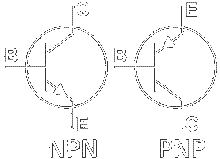|
The "bipolar transistor", technically a "bipolar junction transistor" or BJT,
is a common variety of transistor.
"Bipolar" transistors use both electrons and holes (electron vacancies) as charge carriers.
The following electrical specs are important when choosing a substitute BJT.
Polarity
"Junction" transistors exploit the behavior of junctions between "N-type" and
"P-type" semiconductors. N-type semis contain excess electrons
while P-type semis contain excess
holes.
"NPN" transistors sandwich a P region between two N
regions, creating two junctions. Similarly, "PNP" transistors
sandwich an N region between
two P regions.

The central region is called the base (symbol B). A small current
between the emitter (symbol E) and the base controls a larger current
between the emitter and the collector (symbol C).
A substitute transistor must have the same polarity (NPN or PNP) as the
original. If it has the wrong polarity, it won't work properly
in it's circuit.
Maximum Voltages
If more than a maximum voltage rating is applied to a transistor, it
can be permanently damaged. At the maximum voltage, also called a breakdown voltage
(BV), electrons begin to avalanche in the transistor.
During an avalanche, electrons in the P-N transition regions are
accelerated to energies so high that they hit bound electrons with
enough force to free them, creating additional
charge carriers and greatly multiplying the
transistor current.
There are three breakdown voltages:
-
VCB - the maximum voltage across the Collector-Base terminals
-
VCE - the maximum voltage across the Collector-Emitter terminals
-
VEB - the maximum voltage across the Emitter-Base terminals
In each of these ratings, the 3rd terminal is assumed to be
electrically Open (unconnected). VCE,
for example, may be written as VCEO, BVCEO, or
most correctly as V(BR)CEO.
The VEB rating isn't usually a factor
in choosing a substitute transistor.
VCB is always equal to or greater than VCE
and you can
use either of these maximum voltages to compare transistors. Choose
a substitute transistor with a breakdown voltage rating at least as high as the original.
Maximum Current
Maximum current is the maximum continuous collector current (IC)
that a transistor can withstand without permanent damage.
Small, TO-92 or TO-98 transistors, depending on their fabrication, can handle between about
100 and 1000 mA. A TO-5 package
might be rated as high as 5 amps; a TO-220, as high as 25 A; and a TO-3, up to 500 A.
Be sure to choose a substitute transistor with a maximum current rating at least as high
as the original.
Maximum Power
Maximum Power, called PD, is the overall power a transistor can dissipate, through
heat, without burning up.
Heat sinks and fans increase the ability of a transistor to dissipate
heat. A TO-5 transistor with a PD of
3 watts might be able to dissipate 8-10 watts with a heat sink.
Choose a substitute transistor with a maximum power rating at least as high as the original.
Current Gain
Current gain is only occasionally significant when choosing a substitute transistor.
Actual circuit gain depends on other components. But if the
original transistor has a high gain, try to match it.
Current gain falls off at higher frequencies, so a high-gain transistor can
deliver a wider frequency response than a low-gain transistor.
One measure of gain, called hFE, is often used for
comparing transistors. The capital FE subscript refers to
the
Forward DC current transfer ratio in a common
Emitter circuit. In other words, IC / IB.
Data sheets often specify a minimum or typical value of hFE,
or else a range of values that applies at a certain collector current (IC).
"Darlington" transistors are made up of two transistors in series
and have gains in the thousands, instead of the tens or hundreds. They also have double
the input voltage drop since there are two semiconductor junctions in series.
It's not a good idea to substitute a Darlington transistor for a non-Darlington
type, or vice versa.
|
